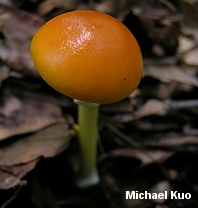| Major Groups > Gilled Mushrooms > Pale-Spored > Amanita > Amanita flavoconia |

|
Amanita flavoconia [ Basidiomycota > Agaricales > Amanitaceae > Amanita . . . ] by Michael Kuo This beautiful mushroom is one of the most common species of Amanita in the Midwest and in eastern North America, where it usually begins to appear in early and mid-summer. The cap is orange to orange-yellow, and often features scattered yellow warts or patches. The stem is pale yellow and has a distinct but small basal bulb. The most distinctive feature of Amanita flavoconia, however, is found at the base of the stem, where the universal veil leaves fragmented, powdery yellow remnants. These patches of tissue are easily lost in the collection process, so be sure to examine the stem base carefully as you dig it up. Similar species include Amanita frostiana, distributed from New York to the maritime provinces, which usually features a whiter stem and a somewhat lined cap margin, as well as a persistent ring of volval material around the upper edge of the stem base and (more definitively) round, inamyloid spores; as well as a poorly known species, Amanita elongata (cap more yellow than orange, stem more white than yellow). Thanks to Roxanne Palmrose for collecting, documenting, and preserving Amanita flavoconia for study; her collection is deposited in The Herbarium of Michael Kuo. Description: Ecology: Mycorrhizal with oaks and other hardwoods, and reported with hemlock and other conifers; growing alone, scattered, or gregariously; summer and fall (or over winter along the Gulf Coast); widely distributed and common east of the Rocky Mountains. The illustrated and described collections are from Illinois, Indiana, and Florida. Cap: 3–9 cm; convex, becoming broadly convex or flat in age; sticky when wet; orange to yellow-orange or orangish yellow (usually becoming more yellow and less orange when in direct sunlight); covered with scattered yellow warts or patches that disappear easily; bald; margin usually not lined, but occasionally slightly lined at maturity. Gills: Free from the stem, or narrowly attached to it; close or crowded; white, sometimes with yellow edges. Stem: 5–12 cm long; 0.5–1 cm thick; tapering to apex and flaring to a slightly enlarged base; bald or slightly roughened; with a high, skirtlike, yellowish ring; pale yellow; base with powdery yellow volval remnants. Flesh: White; thin. Odor: Not distinctive. Chemical Reactions: KOH negative on cap surface. Spore Print: White. Microscopic Features: Spores 6–9 x 4–6 µm; ellipsoid; smooth; amyloid. Pileipellis a cutis or ixocutis of hyphae 3–7 µm wide. Basidia 4-spored; without clamps. Lamellar trama bilateral; subhymenium ramose. REFERENCES: Atkinson, 1902. (Saccardo,1905; Kauffman, 1918; Smith, Smith & Weber, 1979; Thiers, 1982; Arora, 1986; Jenkins, 1986; Phillips, 1991/2005; Lincoff, 1992; Metzler & Metzler, 1992; Horn, Kay & Abel, 1993; Barron, 1999; Roody, 2003; McNeil, 2006; Miller & Miller, 2006; Binion et al., 2008; Kuo & Methven, 2014.) Herb. Kuo 06199501, 06130205, 07080703, 06220804, 06221012, 06221303, 12101502. This site contains no information about the edibility or toxicity of mushrooms. |
© MushroomExpert.Com |
|
Cite this page as: Kuo, M. (2016, July). Amanita flavoconia. Retrieved from the MushroomExpert.Com Web site: http://www.mushroomexpert.com/amanita_flavoconia.html |





